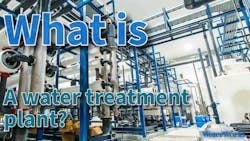What is a water treatment plant?
What is a water treatment plant?
A water treatment plant is a facility that takes raw water from natural sources and processes it so it is safe to drink. These plants are the essential step between rivers, lakes or groundwater and the taps in homes and businesses. By removing contaminants and ensuring compliance with public health standards, treatment plants provide communities with a reliable supply of potable water.
However, natural sources aren't the only way people get their drinking water.
What is potable reuse?
Potable reuse refers to the practice of treating wastewater or reclaimed water to a level that is safe for human consumption. It is an increasingly important solution for regions facing water scarcity, population growth or climate-driven droughts. By recycling water, communities can reduce reliance on traditional sources such as rivers, lakes or aquifers, while maintaining a reliable supply of drinking water.
Indirect Potable Reuse (IPR)
Indirect potable reuse (IPR) involves introducing highly treated wastewater into an environmental buffer – such as a groundwater aquifer, reservoir or river – before it enters the drinking water supply. This environmental buffer serves multiple purposes: it provides additional treatment through natural processes, allows for storage and increases public confidence by creating separation between treated wastewater and drinking water intake. After passing through the buffer, the water is withdrawn, undergoes final treatment at a conventional water treatment plant and is delivered as safe drinking water.
Direct Potable Reuse (DPR)
Direct potable reuse (DPR) bypasses the environmental buffer and sends advanced-treated wastewater directly into a drinking water distribution system or to a treatment plant for final polishing. DPR systems rely on multiple, highly engineered barriers – including microfiltration, reverse osmosis, advanced oxidation and rigorous monitoring – to ensure water meets or exceeds drinking water standards. While DPR is technologically intensive, it offers more immediate augmentation of water supplies and is increasingly being implemented in water-stressed regions around the world.
Why are water treatment plants important?
Water from the environment often carries impurities that make it unsafe without treatment. These may include:
- Microorganisms such as bacteria, protozoa and viruses
- Chemical pollutants like pesticides, nitrates or PFAS
- Metals and minerals that cause hardness or corrosion issues
- Sediment and organic matter that affect clarity and taste
Treatment plants reduce or eliminate these risks to meet the requirements of the Safe Drinking Water Act and other regulatory standards.
How does a water treatment plant work?
Although processes differ depending on the source, most plants follow a similar sequence:
- Coagulation and flocculation – Chemicals are added to bind small particles into larger clumps.
- Sedimentation – Floc settles to the bottom, separating from cleaner water.
- Filtration – Water passes through sand, gravel or membranes to remove fine particles.
- Disinfection – Chlorine, chloramine, ozone or ultraviolet light is used to inactivate pathogens.
- Finishing steps – Some plants add corrosion inhibitors or fluoride, depending on local needs.
Types of plants
- Conventional treatment plants use coagulation, sedimentation, filtration and disinfection, and are common for surface water.
- Membrane plants employ reverse osmosis or ultrafiltration to remove dissolved solids and emerging contaminants.
- Groundwater treatment systems focus on targeted issues such as iron, arsenic or nitrates, along with disinfection.
Why it matters
Water treatment plants safeguard public health and enable modern life. Today, they face challenges from aging infrastructure, stricter regulations and emerging contaminants such as PFAS and microplastics. Utilities are investing in advanced treatment technologies and improved monitoring to keep drinking water safe as conditions change.

